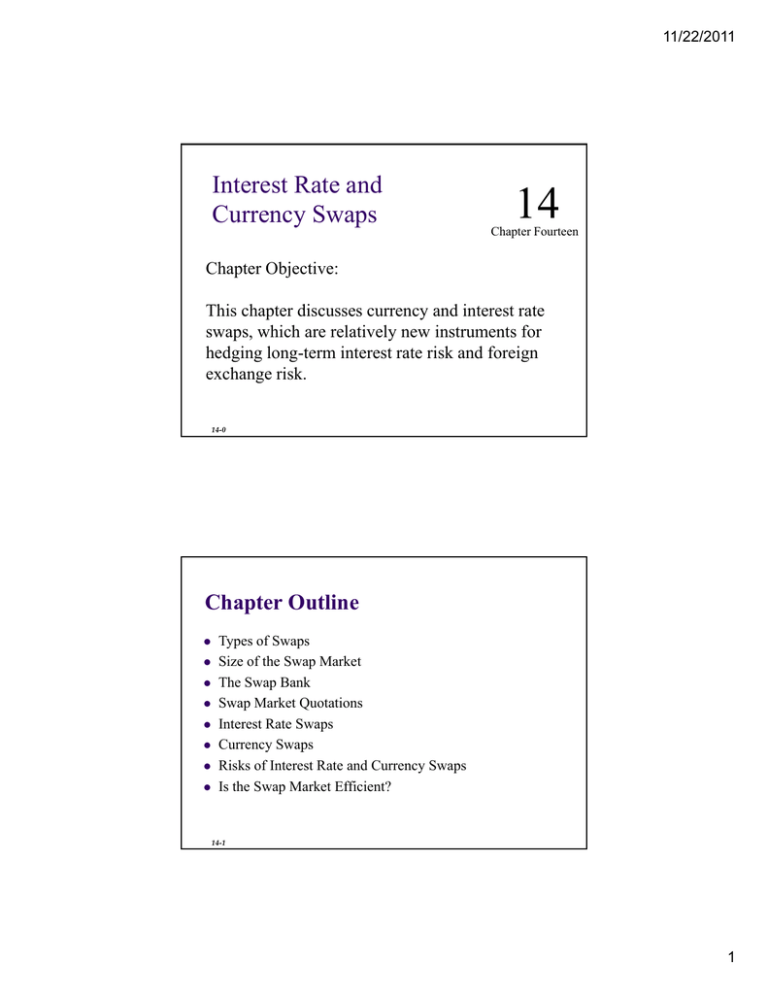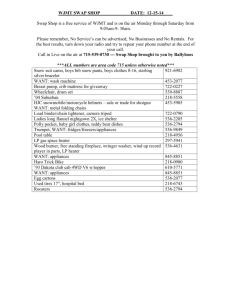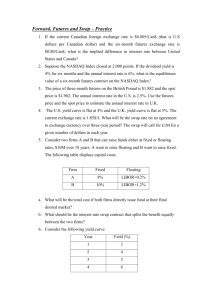
11/22/2011
Interest Rate and
Currency Swaps
14
Chapter Fourteen
Chapter Objective:
This chapter discusses currency and interest rate
swaps,
p , which are relatively
y new instruments for
hedging long-term interest rate risk and foreign
exchange risk.
14-0
Chapter Outline
Types of Swaps
Size of the Swap Market
The Swap Bank
Swap Market Quotations
Interest Rate Swaps
Currencyy Swaps
p
Variations
Variations
Risks
of Interest
of
of Basic
Basic
Rate
Interest
Interest
and Currency
Rate
Rate and
andSwaps
Currency
Currency Swaps
Swaps
Risks
Is
the Swap
of Interest
Market
Rate
Efficient?
and Currency Swaps
Is the Swap Market Efficient?
14-1
1
11/22/2011
Definitions
In a swap, two counterparties agree to a
contractual arrangement wherein they agree to
exchange cash flows at periodic intervals.
There are two types of interest rate swaps:
Single currency interest rate swap
“Plain
Plain vanilla”
vanilla fixed
fixed-for-floating
for floating swaps are often just called
interest rate swaps.
Cross-Currency interest rate swap
This is often called a currency swap; fixed for fixed rate debt
service in two (or more) currencies.
14-2
Size of the Swap Market
In 2007 the notational principal of:
Interest rate swaps was $271.9 trillion USD.
Currency swaps was $12 trillion USD
The most popular currencies are:
U.S. dollar
Japanese yen
Euro
Swiss franc
British pound sterling
14-3
2
11/22/2011
Global FX Market Share: By Instruments
14-4
The Swap Bank
A swap bank is a generic term to describe
a financial institution that facilitates
swaps between counterparties.
The swap bank can serve as either a
broker or a dealer.
A a bbroker,
As
k the
h swap bbank
k matches
h counterparties
i bbut
does not assume any of the risks of the swap.
As a dealer, the swap bank stands ready to accept either
side of a currency swap, and then later lay off their risk,
or match it with a counterparty.
14-5
3
11/22/2011
Interest Rate Swaps: Basics
Three Parties
A fixed rate p
payer,
y who wants to swap
p to floating
g rate
A floating rate payer, who wants to swap to fixed rate
An intermediary, the Swap Bank, who arranges the swap
Receives floating rate form the fixed rate payer, and takes over
the fixed rate payment on his/her behalf
Receives fixed rate form the floating rate payer, and takes over
the floating rate payment on his/her behalf
Receives a fee from both for arranging the deal
The interest payments of the first two parties change
The Notional Principle does not change
14-6
The convention is to quote against U.S. dollar LIBOR.
Interest Rate Swap Quotations
Euro-€
Bid
Ask
£ Sterling
Swiss franc
Bid
Bid
Ask
Bid
Ask
Ask
U.S. $
1 year
2.34
2.37
5.21
5.22
0.92
0.98
3.54
3.57
2 year
2.62
2.65
3 year
2.86
2.89
5.14
5.18
1.23
1.31
3.90
3.94
4 year
3.06
3.09
5 year
3.23
3.26
6 year
3.38
3.41
7 year
3.52
3.55
8 year
3.63
3.66
5.10
5.15
2.37
2.45
4.62
4.66
9 year
3.74
3.77
5.09
5.14
4.48
2.56
4.70
4.72
10 year
3.82
3.85
5.08
5.13
2.56
2.64
4.75
4.79
3.82–3.85
means1.50
the swap
5.13
5.17
1.58 bank
4.11will pay
4.13
fixed-rate
euro payments
5.12
5.17
1.73
1.81at 3.82%
4.25
4.28
against
receiving
dollar2.01
LIBOR
or it will
5.11
5.16
1.93
4.37
4.39
receive
fixed-rate
fi5.16d t2.10euro 2.18
payments
t att 4.50
5.11i
4.46
3.85%
against
paying
dollar
LIBOR
5.10
5.15
2.25
2.33
4.55
4.58
14-7
4
11/22/2011
Swap Quotations
3.82–3.85 means the swap bank will pay fixed-rate
euro payments
t att 3.82%
3 82% against
i t receiving
i i dollar
d ll
LIBOR or it will receive fixed-rate euro payments at
3.85% against paying dollar LIBOR
Firm
B
€3.85%
$LIBOR
Swap
B k
Bank
Firm
A
€3.82%
$LIBOR
While most swaps are quoted against “flat” dollar
LIBOR, “off-market” swaps are available where
one party pays LIBOR plus or minus some number.
14-8
Example of an Interest Rate Swap
Consider firms A and B;
each firm wants to borrow
$40 million for 3 years.
years
Fixed
Floating
A
5%
LIBOR
B
5.50% LIBOR + .20%
Firm A wants to finance an interest-rate-sensitive asset and
therefore wants to borrow at a floating rate.
A has good credit and can borrow at LIBOR
Firm B wants to finance an interest-rate-insensitive asset and
therefore wants to borrow at a fixed rate.
B has less-than-perfect credit and can borrow at 5.5%
The swap bank quotes 5.1—5.2 against dollar LIBOR for a
3-year swap.
14-9
5
11/22/2011
Example of an Interest Rate Swap
Firm 5.10%
A
LIBOR
Swap
Bank
If Firm A borrows from their bank at 5.0% fixed
and takes upp the swapp bank on their offer of
5.1—5.2 they can convert their fixed rate 5%
debt into a floating rate debt at LIBOR – 0.10%
Bank
X
A’s all-in-cost:
= 5.0% + LIBOR – 5.10% = LIBOR – 0.10%
14-10
Example of an Interest Rate Swap
Swap
Bank
Firm
B
LIBOR
5.20%
If Firm B borrows floating from their bank at
LIBOR + 0.20% and takes up the swap bank on
their offer of 5.1—5.2 they can convert their
floating rate debt into a fixed rate debt at 5.40%
B’s all-in-cost:
= –LIBOR + LIBOR + 0.20% + 5.20% = 5.40%
Bank
Y
14-11
6
11/22/2011
Example of an Interest Rate Swap
Firm 5.10%
A
LIBOR
Swap
Bank
Firm
B
LIBOR
5.20%
The Swap Bank makes 10 basis points on the deal:
The Swap Bank’s all-in-cost:
= –LIBOR + LIBOR – 5.20% + 5.10% = –0.10%
14-12
Example of an Interest Rate Swap
Firm 5.10%
A
LIBOR
Swap
Bank
Firm
B
LIBOR
5.20%
The notional size is $40 million.
The tenor is for 3 years.
Bank
X
A earns $40,000 per year on the swap.
B earns $40,000 per year on the swap.
Swap Bank earns $40,000 per year.
Bank
Y
14-13
7
11/22/2011
Using a Swap to Transform a Liability
Firm A has transformed a fixed rate liability
into a floater.
Firm B has transformed a floating rate
liability into a fixed rate liability.
B iis borrowing
b
i at 5.40%
5 40%
A savings of 10 bp
A is borrowing at LIBOR – .10%
A savings of 10 bp
The Swap Bank also generates a profit of 10 bp
14-14
The QSD
•
The Quality Spread Differential represents the potential
gains from the swap that can be shared between the
counterparties and the swap bank.
Fixed
Floating
A
5.00%
Libor
B
5.50%
Libor + 0.20%
QS
0.50%
0.20%
0.30%
The 0.30% QSD is
the difference
between the two
quality spreads
• In this case, the 0.30%, or 30 bp, QSD is equally shared
between the two counterparties and the Swap Bank.
• But there is no reason to presume that the gains will be
shared equally.
14-15
8
11/22/2011
What about the Principal?
In our “plain
p
vanilla” interest-onlyy interest
rate swap just given, we did not mention
swapping the Notational Principal.
It could be the case that firm A exchanged
principal with their lender (Bank X) and
firm B exchanged principal with their
outside lender, Bank Y.
14-16
Cash Flows of an Interest-Only Swap: T = 0
Firm
A
Bank
X
Swap
Bank
Firm
B
Bank
Y
14-17
9
11/22/2011
Cash Flows of an Interest-Only Swap: T = 1
Assume LIBOR = 3%
Firm
A
$2,040,000
$1,200,000
Swap
Bank
Firm
B
$1,200,000
$2,080,000
Swap Bank earns $40,000 per year.
A saves $40,000
$40 000 per year relative to
borrowing at LIBOR = 3%.
Bank
X
B saves $40,000 per year relative to
borrowing at 5.5%.
Bank
Y
14-18
Cash Flows of an Interest-Only Swap: T = 2
Assume LIBOR = 4%
Firm
A
$2,040,000
$1,600,000
Swap
Bank
Firm
B
$1,600,000
$2,080,000
Swap Bank earns $40,000 per year.
A saves $40,000
$40 000 per year relative to
borrowing at LIBOR = 4%.
Bank
X
B saves $40,000 per year relative to
borrowing at 5.5%.
Bank
Y
14-19
10
11/22/2011
Cash Flows of an Interest-Only Swap: T = 3
Assume LIBOR = 5%
Firm
A
$2,040,000
$2,000,000
Swap
Bank
Firm
B
$2,000,000
$2,080,000
Swap Bank earns $40,000 per year.
A saves $40,000
$40 000 per year relative to
borrowing at LIBOR = 4%.
Bank
X
B saves $40,000 per year relative to
borrowing at 5.5%.
Bank
Y
14-20
Currency Swap Agreement
Two counterparties use a Swap Bank to:
Convert a liability denominated in one currency
into a liability denominated in another currency
Swap principal in the beginning
Swap interest during the period
Return swapped principle at the end
Equivalent to a series of forward contracts
14-21
11
11/22/2011
Example of an Currency Swap
$
€
Firm A is a U.S. MNC and wants to
borrow €40 million for 3 years.
A $7% €6%
Firm B is a French MNC and wants to
B $8% €5%
borrow $60 million for 3 years
Firm A wants finance euro denominated asset in Italy and
therefore wants to borrow euro.
A can borrow euro at 6%
Fi B wants finance
Firm
fi
a dollar
d ll denominated
d
i
d asset andd
therefore wants to borrow dollars.
B can borrow dollars at 8%
The current exchange rate is $1.50 = €1.00
14-22
Comparative Advantage
as the Basis for Swaps
A has a comparative advantage in borrowing in
dollars.
B has a comparative advantage in borrowing in
euro.
$
€
A $7%
€6%
B $8%
€5%
14-23
12
11/22/2011
Example of a Currency Swap
Suppose
that the Swap Bank publishes these quotes.
The convention is to quote against U.S. dollar LIBOR.
Euro-€€
Euro
Bid Ask
3 year 5.00 5.20
U.S.
U
S $
Bid
Ask
7.00
7.20
Firm A wants finance euro-denominated
assett in
i Italy
It l andd wants
t to
t borrow
b
euro.
$
A can borrow euro at 6% or they can
borrow euro at 5.2% by using a
currency swap.
€
A $7%
€6%
B $8%
€5%
14-24
Example of a Currency Swap
(The convention is to quote against U.S. dollar LIBOR.)
Euro-€
Bid Ask
5.00 5.20
$
U.S. $
Bid
Ask
7.00
7.20
€
A $7%
€6%
B $8%
€5%
LIBOR
$7.0%
$60m
Firm A then enters in to 2
fixed14-25for floating swaps.
$60m
Suppose that Firm A borrows
$60m at $7%; trades for € at spot.
Firm
A
€40m
Bank
X
$7.0%
€5.2%
LIBOR
Swap
Bank
FOREX Market
13
11/22/2011
Example of a Currency Swap
(The convention is to quote against U.S. dollar LIBOR.)
Euro-€
Bid Ask
5.00 5.20
$
U.S. $
Bid
Ask
7.00
7.20
€
A $7%
€6%
B $8%
€5%
LIBOR
$7.2%
€40m
€5.0%
LIBOR
Firm
B
$60m
Swap
Bank
€40m
€5%
Bank
Y
Suppose that Firm B borrows
€40m at €5%, trades for $.
FOREX Market Firm B then enters in to 2
fixed for floating swaps.
14-26
Example of a Currency Swap
Swap Bank earns 40 bp per year (20bp in $ and 20bp in €).
Firm
A
Bank
X
$7.0%
€5.2%
Swap
Bank
Firm
B
€5.0%
$7.2%
The notional size is $60m for 3 years.
Firm A earns 80 bp per year on the swap and
hedges exchange rate risk.
Firm B earns 80 bp per year on the swap
and hedges exchange rate risk.
Swap Bank earns 40 bp per year
Bank
Y
14-27
14
11/22/2011
Cash Flows of the Swaps: T = 0
Firm
A
Bank
X
Swap
Bank
Firm
B
Bank
Y
Foreign Exchange
Spot Market
14-28
Cash Flows of the Swaps: T = 1
Assume LIBOR = 3%
$1.8m
Firm
A
Bank
X
$4 2
$4.2m
€2.08m
$1.8m
$1.8m
Swap
Bank
$4 32
$4.32m
€2m
$1.8m
Firm
B
Swap bank earns €80,000 + $120,000
or .002×€40m + .002×$60m per year.
Firm A’s all-in-cost
€2.08m or
5.2% of €40m
Firm B’s all-in-cost
$4.32 or
7.2% of $60m
Bank
Y
14-29
15
11/22/2011
Cash Flows of the Swaps: T = 2
Assume LIBOR = 4%
$2.4m
Firm
A
$4 2
$4.2m
€2.08m
$2.4m
$2.4m
Swap
Bank
$4 32
$4.32m
€2m
$2.4m
Firm
B
Bank
X
Bank
Y
14-30
Cash Flows of the Swaps: T = 3
Assume LIBOR = 5%
$3m
Firm
A
$4 2m
$4.2m
€2.08m
$3m
$3m
Swap
Bank
$4 32m
$4.32m
€2m
$3m
Bank
X
14-31
Firm
B
Bank
Y
Foreign Exchange
Forward Market
16
11/22/2011
Example of a Direct Currency Swap
If firms A and B knew and trusted each
other, they could theoretically cut out the
swap bank:
$7.0%
Firm
Firm
A
Bank
X
€5.0%
$
€
A $7%
€6%
B $8%
€5%
B
The problem is of course that the swap
bank is acting as a broker (or even a
dealer) and providing a service—that’s
why they get paid.
Bank
Y
Signing 1 contract is less work than 4.
14-32
Equivalency of Currency Swap
A
Debt Service Obligations
$
€
$7%
€6%
B $8%
€5%
We can assume that IRP holds between the 5% euro
rate and the 7% dollar rate.
This is reasonable since these rates are, respectively, the
best rates available for each counterparty who is well known
in its national market.
((1 + i )t
According to IRP:
Ft = S0 × (1 + i$)t
€
F1 = $1.50 ×
(1.07)1
(1.05)1
F2 = $1.50 ×
(1.07)2
(1.05)2
F3 = $1.50 ×
(1.07)3
(1.05)3
14-33
17
11/22/2011
Swap: A Series of Forward Contracts
Year
0
S0
FX
1.50
IRR
CF0
7.00% –$60.00
1
F1
1.5142
CF1
$4.20
2
F2
1.5577
CF2
$4.20
3
F3
1.5874
CF3
$64.20
5 00% –€40
5.00%
€40.00
00
€2 75
€2.75
€2 70
€2.70
€40 44
€40.44
5.00% –€40.00
€2.00
€2.00
€42.00
7.00% –$60.00
$3.06
$3.12
$66.67
14-34
IRR
0
1
2
3
7.00%
–$60.00
$4.20
$4.20
$64.20
5.00%
–€40.00
€2.75
€2.70
€40.44
The swapp bank could borrow $60m at 7% and use a set of 3
forward contracts to redenominate their bond as a 5% euro
bond.
€1.00
(1.07)
–€40m = –$60m×
€2.7477m = $4.20m ÷ $1.50 ×
$1.50
(1.05)
(1.07)2
€2 6963m = $4.20m
€2.6963m
$4 20m ÷ $1.50
$1 50 ×
(1.05)2
(1.07)3
€40.4446m = $64.20m ÷ $1.50 ×
(1.05)3
14-35
18
11/22/2011
IRR
0
1
2
3
5.00%
–€40.00
€2.00
€2.00
€42.00
7.00%
–$60.00
$3.06
$3.12
$66.67
The swap bank could borrow €40m at 5% and use a set of 3
forward contracts to redenominate their bond as a 7% dollar
bond.
(1.07)
–$60m = –€40m× $1.50
$3.06m = €2m × $1.50 ×
(1.05)
(1 07)2
(1.07)
$3.12m = €2m × $1.50 ×
(1.05)2
$66.67m = €42m × $1.50
(1.07)3
(1.05)3
14-36
Equivalency of Currency Swap Debt
Service Obligations
The ability to hedge with covered interest arbitrage
is where the swap bank found the €5% and $7%
rates Euro-€
U.S. $
Bid
Ask
5.00 5.20
Bid
Ask
7.00
7.20
Competition from other swap banks will keep their
spreads from getting too wide—the theoretical limit
is 200 basis points total. (See QSD on next slide.)
14-37
19
11/22/2011
The QSD: Currency Swap
The QSD is calculated as the difference between
the spreads in the two countries
QSD = 1 – (-1) = 2% = 200 bp
A & B earn 80 bp each, while Swap Bank earns 40
bp
$
€
A
7%
6%
B
8%
5%
QSD
1%
–1%
14-38
Risks of Interest Rate
and Currency Swaps
Interest Rate Risk
Basis Risk
Interest rates might move against the swap bank after it
has only gotten half of a swap on the books, or if it has
an unhedged position.
If the floating rates of the two counterparties are not
pegged to the same index
index.
Exchange rate Risk
In the example of a currency swap given earlier, the
swap bank would be worse off if the pound appreciated.
14-39
20
11/22/2011
Risks of Interest Rate
and Currency Swaps (continued)
Credit Risk
Mismatch Risk
This is the major risk faced by a swap dealer—the risk
that a counter party will default on its end of the swap.
It’s hard to find a counterparty that wants to borrow the
right amount of money for the right amount of time.
S
Sovereign
i Risk
Ri k
The risk that a country will impose exchange rate
restrictions that will interfere with performance on the
swap.
14-40
Swap Market Efficiency
Swaps offer market completeness and that has
accounted for their existence and growth.
Swaps assist in tailoring financing to the type
desired by a particular borrower. Since not all
types of debt instruments are available to all types
of borrowers
borrowers, both counterparties can benefit (as
well as the swap dealer) through financing that is
more suitable for their asset maturity structures.
14-41
21
11/22/2011
Concluding Remarks
The growth of the swap market has been
astounding.
Swaps are off-the-books transactions.
Swaps have become an important source of
revenue and risk for banks
14-42
Sample Interest Rate Swap Problem
A is a credit-worthy firm
B is a less-credit-worthy firm
A can borrow at 8% fixed
A can borrow at flat LIBOR
A prefers to borrow floating
B can borrow at 9% fixed
B can borrow at LIBOR + ½%
B prefers to borrow fixed
Fixed Floating
A 8% LIBOR
B 9% LIBOR + ½
Both firms want a 10-year maturity
Devise a swap that is mutually beneficial for A and B.
Follow the convention of pricing against “flat” LIBOR.
14-43
22
11/22/2011
Step 2: We are to quote the swap against flat LIBOR
Step 4: check our work
Step 3: The QSD = ½
so we have 50 bp to
A’s all-in-cost:
distribute among 3
LIBOR – 0.2
players. Let’s try 20 forLIBOR
LIBOR
B’s all-in-cost:
(Step 2)
A and B,
(Step 2)
8.8%
(this leaves 10 bp
Swap Bank Profit:
Profit
f the
for
th swap bbank)
k)
8.2% 8.3%
10 basis points
(Step 3)
Swap
Bank
(Step 1)
8%
Outside
Lender
X
14-44
A
B
(Step 1)
LIBOR + ½
Step 1: A is better at borrowing fixed; B is better at
borrowing floating so have them borrow externally
y
according to their comparative advantage
Fixed
A 8%
B 9%
QSD = 1% –
Floating
Outside
Lender
LIBOR
LIBOR + ½
½%
= ½%
Y
Sample Currency Swap Problem
A is an Italian firm
B is an American firm
A can borrow in euro at 5% fixed
A prefers to borrow in dollars but faces 8% cost
B can borrow in dollars at 7½%
B now prefers to borrow in euro but faces 6% cost
Both firms want a 10-year maturity
Devise a feasible swap that eliminates exchange
rate risk for A and B
23
11/22/2011
Step 2: We are to eliminate exchange rate risk for A and B
Step 3: The QSD =1.5%
so we have 150 bp to
distribute among 3
players. Let’s try 25 bp €5%
for A, 75 bp for B, and (Step 2)
50 bp
b for
f Swap Bank
(Step 1)
€5%
Outside
LenderX
A
Step 4: check our work
A’s all-in-cost: $7.75%,
producing a 25 bp savings
Swap
$7.5%
Bank (Step
2)
$7.75% €5.25%
(Step 3)
$
B
€
A 8%
5%
B 7.5%
7 5%
6%
B’s all-in-cost:
€5.25%, producing
a 75 bp savings
Swap Bank Profit:
50 basis points
(Step 1)
$7.5%
Step 1: A is better at borrowing €;
B is better at borrowing $
so have them borrow externally according to their
comparative advantage
Outside
LenderY
Copyright © 2005 by The McGraw-Hill Companies, Inc. All rights reserved.
The First Major Currency Swap: 1981 IBM/World
Bank : IBM’s Perspective
• IBM wanted to call its Deutsche Mark (DEM) and Swiss Franc
(CHF) debt: the USD had appreciated considerably and the DM
and SF interest rates had also gone up. Due to a depreciation
of the DM and Swiss franc against the dollar
dollar, IBM could realize
a large foreign exchange gain, but only if it could eliminate its
DEM and CHF liabilities and “lock in” the gain.
But this would be costly:
• Exchange transaction costs when IBM buys DEM and CHF
• Call premium: IBM has to pay more than the DEM and
CHF face value
• Issuing costs when IBM issues new USD bonds.
• Capital gains taxes on realized gain
24
11/22/2011
The First Major Currency Swap: 1981 IBM/World
Bank: World Bank’s Perspective
• The World Bank (WB) wanted to borrow DEM and CHF to lend
to its customers.
• Though it wanted to lend in DM and Swiss francs, the bank was
concerned that saturation in the bond markets could make it difficult to
borrow more in these two currencies at a favorable rate.
• The WB was raising most of its funds in DEM (interest rate = 12%)
and Swiss francs (interest rate = 8%).
• It did not want to borrow in USD (interest rate = 17)
Note that:
• IBM wanted to retire CHF and DEM bonds (at a rather high cost)
• WB wants to issue CHF and DEM bonds (also at a cost).
• To avoid most of these costs, IBM and WB agreed that WB would take
over IBM’s foreign debt instead
• Salmon Brothers arranged the Swap
The Basic Swap Agreement
• WB borrows USD instead of DEM, CHF. With the proceeds it buys
spot CHF and DEM for its loans
• WB undertakes to deliver to IBM the DEM and CHF necessary
to service IBM’s old DEM and CHF loans,
• IBM promised to provide the WB with the USD needed
to service the WB's (new) USD loan;
25
11/22/2011
Overview
26





